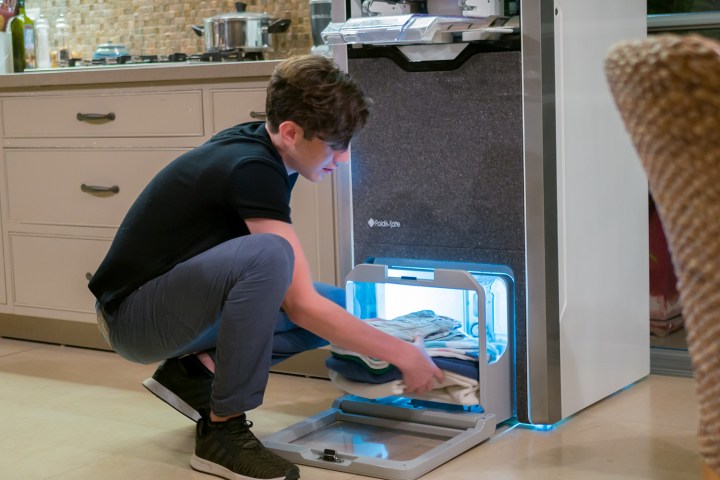
Mirror, mirror, on the wall
There’s nothing like getting up for work on a rainy Monday, only to have your bathroom mirror quickly run down everything that’s wrong with your face. Okay, so that’s an uncharitable version of what the HiMirror Mini does, but it’s not a million miles off, either. An Amazon Alexa-integrated smart mirror that uses artificial intelligence (A.I.) to pick out every flaw, wrinkle, pimple and blemish on your face, and track your “skin care goals” over time, the Mini offers a glimpse at what the bathroom of the future may look like.
In terms of image-recognition technology, it’s kind of awesome. Although we do have our doubts about its impact on the self-esteem of people who may already be too concerned about their appearance.
The world’s most comprehensive water drone
There’s a classic Saturday Night Live joke about a multipurpose product that’s both a floor wax and a dessert topping. At CES 2018, the equivalent to that may well be PowerDolphin, an RC boat (or, if you will, a water-based drone) that packs so many features you get the feeling its creators wrote down and used every single suggestion in all their product development meetings.
The PowerDolphin packs a camera for both above- and below-water photography, sonar detector for making topographical maps, and the ability to autonomously release bait and catch fish. What more could you want from a self-described “lifestyle robot?”
An airbag belt
Ever felt the need for a wearable airbag system for your hip? That’s exactly what Helite’s Hip’Air promises, with a belt that’s able to inflate into a protective airbag in less than a third of one second. The device works by analyzing its wearer’s movements and detecting when a fall may be about to happen. It then inflates itself using a replaceable CO2 canister.
The device could be used for everything from horse riding and skiing to keeping loved ones safe around the house.
The smartest toilet you’ve ever sat on
If you’ve ever wanted to speak to your toilet, you’ll soon get your chance thanks to Kohler’s high-tech, internet-connected $6,300 device. Offering Siri, Alexa, and Google Assistant integration, the toilet can activate its bidet feature, lift its lid, keep track of water usage, and even blast your favorite tunes while you’re doing your business.
Man’s best robot friend
Robots may one day be on track to rule the Earth, but for now it seems that they’re quite happy to be our pets. Shown off at CES, Sony’s revamped Aibo robot dog (the first-gen version launched way back in the 1990s) shows that you can indeed teach an old dog new tricks.
The robotic puppy now includes OLED eyes for more realistic expressions, A.I. capabilities that allow it to develop its own personality, and even image recognition for distinguishing between objects or telling members of the family apart. And, yes, if one member of the family interacts with Aibo the most, they will become its favorite.
An unnecessary gadget? Sure. An adorably cute unnecessary gadget? You bet!
A flying smartphone case
How did you make it through your life this far without having a flying smartphone case? That’s what the folks behind the Selfly want you to ask yourself. Basically a flying selfie stick, the Selfly promises to fulfill the dream of a person grabbing their smartphone, popping out the miniature drone that lives in its case, and then launching it upwards into the sky to take 13-megapixel images from above.
The Selfly can also record 1080p video at 60fps, and claims a battery life of up to four minutes, which should be more than enough for most instances. The fact that its priced starting at just $130 means it’s also affordable enough (kind of!) that many folks may be willing to take a gamble on it.
Brain-reading tech for drivers
Every car manufacturer is obsessed with making autonomous cars a reality these days, but Nissan is giving human drivers a new way to compete with their robot counterparts: brain-to-vehicle technology. The company’s in-development B2V tech is designed to read a driver’s brain waves and make their car react accordingly.
It’s kind of genius — although the brain wave-reading cap you’d have to wear would make us a bit embarrassed about stopping at a red light next to someone we knew.
A robot that folds your clothes
Folding laundry sucks. Robots don’t. A robot folding laundry may be the best of all. That’s what the makers of Foldimate, a robotic clothes-folding machine, hope to make a mainstream part of every home.
Boasting the ability to fold an average laundry load of up to 40 items in just four minutes (although you have to manually attach each separate item for it to do this), Foldimate uses its multitude of clothes-folding robot arms to inject a much-needed dose of fun into one of the most monotonous tasks around.
Never have we wanted a worse idea to prove us wrong and take the world by storm. Even if the $980 price tag does make that a bit unlikely.


